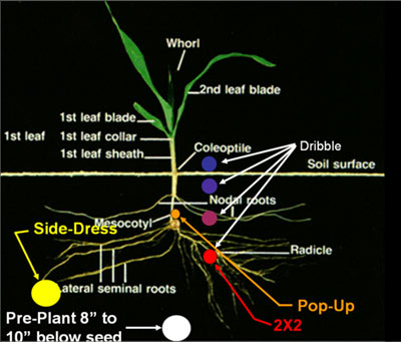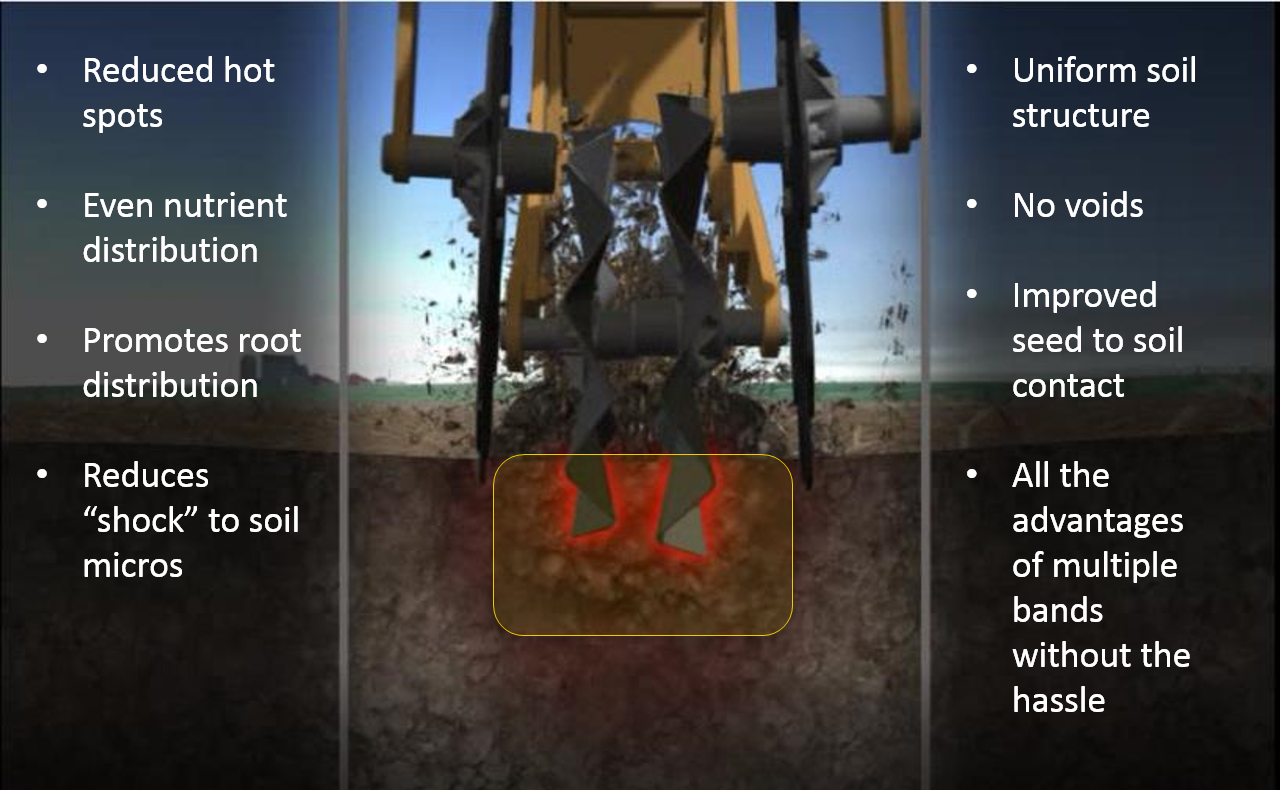Is Zone Placement Better Than Banding Fertilizer?
Article Highlights
- Deep placement should not be your only nutrient application method as nutrients may not be available to the crop when needed.
- Concentrating nutrients in one location can cause the remaining root zone to become nutrient deficient.
- A multiple band approach often requires several passes through the field and many expensive attachments to planting equipment.
- Zone placement combines the benefits associated with multiple bands in an efficient, single pass operation that manages residues and creates an ideal seedbed.
Methods Matter
Is how we apply nutrients as important as what we apply? I would say yes. There are many ways we can supply nutrients in a row cropping system, such as: surface broadcast, deep injection, in-furrow, 2x2 banding, foliar feeding, fertigation, side-dress and zone placement just to name a few. Each of these methods have their own particular benefits as well as limitations. Let’s look at the advantages and disadvantages of just a few of these application methods. In particular, we will review pre-plant or at-planting methods of nutrient placement.
- Surface broadcast nutrient application has the benefit of being a fast method of applying nutrients and is often the least expensive method of application. However, broadcasting nutrients carries a greater risk of nutrient losses due to volatility, tie-up in crop residues or even erosion losses due to runoff. We can help mitigate some of the losses with tillage for incorporation, but you will incur the time and expense of an additional field operation. Full surface tillage can also create additional issues with loss of valuable residues, a decrease in organic matter and poor soil structure.
- Deep placement, also called injection, eliminates volatility losses by placing nutrients below the soil surface. However, this operation is often limited to a narrow window of soil conditions. Trying to do deep placement in wet soil conditions often leaves an open trench resulting in a seedbed that is unsuitable for planting and stand establishment. Deep placement of nutrients can help with late season nutrient availability in some conditions, but placement beyond 6 inches deep should never be the only method of nutrient application. Studies indicate that over 50% of a crop’s root mass is concentrated within the top 6 to 8 inches of the soil profile; if all nutrients are placed below that level in an environment that is often colder and less oxygenated, they may not be available to the crop when needed.
- In-furrow placement is optimal for nutrient availability to newly emerging plants as nutrients are placed in a concentrated band below the soil surface. The limitation of in-furrow, or pop-up fertilizer placement as it is often referred to, is that many of the nutrients are in a salt formulation and can prove to be very toxic to germinating crops. The amount of nutrients that can be safely applied to the seed in-furrow are often far deficient in terms of meeting the nutrient needs of today’s high-yield crops.
- 2” x 2” banding on the planter is an ideal method allowing nutrients to be available to the crop early in its development. By placing the nutrients close to the row in a concentrated band, this method helps avoid nutrient tie-up often associated with broadcast application. The drawback to banding is that it often requires costly attachments on the planter which can potentially affect the seedbed. Additionally, with timeliness being critical during planting, the time lost to filling fertilizer can cause costly delays should a weather delay be encountered. While moving the nutrient bands out of the seed furrow adds a measure of safety to the germination process, these high nutrient concentrations can be detrimental to soil microbiology and even cause root burn until the nutrients diffuse through the soil.
Concentrated Nutrients
When considering nutrient placement in concentrated bands, whether that be in-furrow, 2” x 2”, or deep banding, all of these methods can increase nutrient availability by reducing nutrient tie-up. However, concentrating nutrients in one location can cause the remaining root zone to become nutrient-deficient. The image below shows how plants will increase root development in an area of high nutrient concentration. Concentrating a high percentage of the crop’s root mass in only one area of the soil profile could reduce the plant’s ability to take up water and nutrients from other areas in the soil profile.

Source: Rasmussen, Centre for Plant Integrative Biology, University of Nottingham, UK & Schmidt, School of Agriculture and Food Science, University of Queensland
Multiple Band Approach
To avoid nutrient concentrations so high as to reduce germination or cause root burn while maintaining nutrient placement in the rooting zone of the growing crop, many producers are implementing a multiple band approach as illustrated by the image below. As you can see, the theory is to place some nutrients in-furrow for availability to the newly emerging plant. Then, more nutrients are placed with a 2” x 2” band for utilization during early vegetative stages. More nutrients are potentially added as a surface band that would move into the soil and be used by roots near the surface while more nutrients may be placed deep below the plants as well. While this multiple band approach results in greater nutrient availability and keeps salt concentrations below toxic levels by distributing multiple bands in the root zone, it often requires several passes through the field and many expensive attachments to planting equipment.

Source: Russell French, DuPont Pioneer
Zone Placement
How can we combine the key benefits of multiple application methods? Zone fertility placement allows us to balance the benefits of nutrient concentration while diluting nutrients enough to reduce the detrimental effects of high salt concentrations on germination and root burn. It also allows us to place nutrients throughout the root zone to promote better root distribution. With zone placement, nutrients are placed during a strip-till operation, providing nutrient incorporation to reduce volatility losses while maintaining the valuable crop residues that help control erosion losses associated with conventional tillage. Further, zone placement blends nutrients throughout the tilled strip creating a nutrient rich zone encompassing the roots of the plant to encourage good root development, which is vital to water and nutrient uptake throughout the growing season. Zone placement gives growers all the benefits associated with multiple bands with the efficiency of a single pass operation that manages residues and creates an ideal seedbed as illustrated by the image below.


Comment